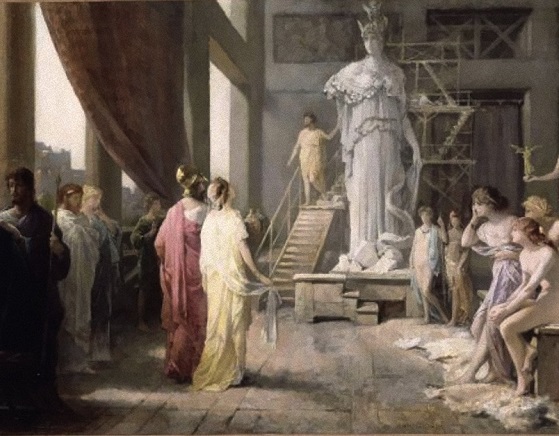Women-Philosopher Archetypes of the Ancient World.

My search for the archetypes of women empowered both spiritually and sexually has taken me to some interesting places.
I have been fascinated by how two things have usually happened in the past in depictions of wise or educated women.
One, they have been completely desexualized so as to lose their feminine or sexual allure and made into overly dutiful holy mother types, with the Virgin Mary as the classic example, although there are many other ancient and early Christian examples.
Two, they have been overly sexualized and often called prostitutes or hetairai — educated women who were sexually free and possibly high class escorts who would entertain learned men as much in the art of philosophy as in the art of sexual performance.
It is my belief based on my research — as much as it is possible to research things that have been purposefully repressed through millennia — that both depictions are likely to be wrong.
I do not doubt there were some highly educated prostitutes known as hetairai but I am convinced many other women-philosophers were put into this category out of contempt for women, especially for educated women, a concept considered indecent and scandalous.
Since educated women or women-philosophers have nearly always been recorded as indecent and scandalous then, I have no doubt, by extension they were defined as whores because they dared to excel in matters of mind and spirit. It is also worth mentioning that apart from courtesans, hetairai also meant companions.
Joan E Taylor, in her book Jewish Women Philosophers of First-Century Alexandria (a book which I think is unnecessarily mistitled, as she discusses largely women-philosophers of the ancient world, including Greek, Jewish and women of other nationalities), refers to paradigms of wise women, which I prefer to refer to as the archetypes of wise women.
I will focus here on some of her excellent distinctions, such as the ‘philosopher babe’, ‘one of the boys’, ‘stuck-up bitch’ and women as carriers of spiritual wisdom in the ancient world.
For me at least, it was a great treat to learn that there have been other women-philosophers, apart from Hypatia of Alexandria, a famous philosopher who in 415 CE/AD was murdered by a Christian mob in the most brutal way (I will spare you the horrific descriptions) by the orders of the new Bishop of Alexandria, Cyril. I have been furious about this since I read the story as a young girl.
With typical misguided flare, the Church made Cyril into a saint.
l am glad that in my search for Mary Magdalene as a wise woman, I have come across so many other women-philosophers. In fact, I have found enough to classify them into different archetypes. For example, Taylor quotes from a Greek philosopher, Chrysippus, who says that he frequently sat next to a female philosophy student in the Stoic school of Cleanthes.
Much later, in the 17th century, Gilles Manage mentions 65 women-philosophers. There is more. Women-philosophers were most eminent in the Stoic, Cynics (the rebels), Pythagorean and Epicurean Schools.
The ones who interest me most are the Pythagoreans, who in mainstream philosophy are usually described as mathematicians but who were also very interested in esoteric spirituality. Taylor, through ancient sources, lists at least 17 famous Pythagorean women-philosophers. Among them, interestingly, is Pythagoras’ wife Theano.
Another wise woman in his life was Themistoclea, who was a Delphic oracle and priestess who once had Pythagoras as a student! Theano was ‘an independent philosopher’ and in charge of the Pythagorean school after his death.
Mary Magdalene was misinterpreted as a prostitute while Sophia, the Divine Wisdom of the Gnostics, was called the ‘lascivious one’. In the mythical rendition of her, she falls into matter, forgets who she is, and becomes a prostitute — a great metaphor for short-changing ourselves in our lives and forgetting our true greatness.
Could it be, I ask, that these depictions of both Mary Magdalene and the Gnostic Super-goddess Sophia have been influenced by the archetype of the sexy and wise babe of the ancient world?
Taylor calls such a woman ‘the blend of erotic adviser’ and a woman of wisdom/philosopher who gives a ‘pillow talk’, but I think this is an unfair description. The archetype of the philosopher-babe encompasses both wisdom and sexiness, something that people even today have difficulty imagining. Such women are beautiful, ‘immodest’ and wise.
Taylor believes these women had and have not only sexual power but also intellectual and possibly spiritual power, especially in the Pythagorean school, which they exercise(d) freely without any regard for social taboos placed on women.
This alone is probably the reason they have pretty much been called whores, in the same way as Mary Magdalene was challenged by some of the male disciples (Peter usually) in the Gnostic sources.
But let’s look at some examples of these magnificent women. According to Taylor, Thargelia of Miletus was ‘beautiful and wise’ and was the lover of Antiochus, King of Thessaly, in 6th century BC. Then there was Cleobulina, who possessed a great mind and participated in the symposium of Seven Sages (also in the sixth century BC) with another woman philosopher called Melissa, who possessed spiritual knowledge.
Let’s then continue with Aspasia (5th century BC) who was a companion and adviser of Pericles, the ruler of Athens, and who, according to ancient sources, also possessed a great sexual allure. These are just some of my favorite of philosopher-babes.
Another archetype that interests me greatly in connection with Mary Magdalene is the archetype of woman as a ‘bearer of a secret knowledge’, as Taylor refers to them. Here we again have Themistoclea, whom I already mentioned was a Delphic priestess who had Pythagoras among her students.
Another of my favorites was Diotima, who initiated Socrates into the secrets of sexual knowledge. She, through her Tantric practices, held that Eros is the source of ‘creation and can potentially be divine, a part in the condition of the mortal and the immortal’.
Another no less interesting but more common archetype also associated with some of the Gnostic descriptions of Mary Magdalene is that archetype which Taylor calls ‘the honorary male’. Hypatia of Alexandria, for example, was ‘one of the boys’. An exception was made for her wisdom, as long as she did not use her feminine allure.
These independent, educated, sexually empowered women were, according to Taylor, considered ‘stuck-up bitches’ who refused to play the part of the ‘virtuous wife’.
I dedicate this article to these magnificent women, whose names have been erased from mainstream history.
They are the rightful daughters of Inanna, Ishtar, Hathor and Isis. They are the archetypes of Mary Magdalene and the Gnostic Sophia. They are the rebels of the mind, soul and body. Stand proud in the glory of your wisdom, creating the space where wisdom and Eros can be one.
***

Dr. Joanna Kujawa is the author of ‘Journaling to Manifest the Lost Goddess in Your Life’ and ‘Jerusalem Diary: Searching for the Tomb and House of Jesus’, and many short stories, essays and academic pieces. She sees herself as a Spiritual Detective who asks difficult questions about spirituality, such as ‘Can spirituality and sexuality be experienced as one?’, ‘Who was the real Mary Magdalene?’, ‘How can we include eco-spirituality in our belief systems?’ and ‘How can we bring back the Divine Feminine to create a more balanced and interconnected world?’ Her goal is to create and participate in the shift in consciousness about spirituality, our connection to nature, and our place in the Universe. She has PhD from Monash University, and MA and BA from the University of Toronto. She is immoderately passionate about her Goddess News blog. You could connect with her via her website, Facebook, Twitter or YouTube.

